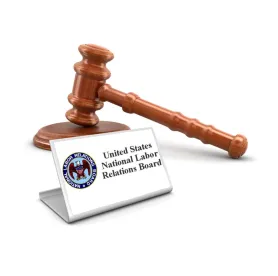The circumstances under which an asset buyer has a duty to bargain with an incumbent union may be changing. In NLRB v. Burns Security Services, Inc., 406 U.S. 272 (1972), the Supreme Court held that an employer who purchases the assets of a unionized business (and who may ultimately qualify as a successor employer with a duty to recognize and bargain with a union) is still free to set the initial wages, hours and working conditions of those it offers employment to unless the new employer clearly plans to retain all of its predecessor ’s unionized employees, rendering the new employer what is known as a “perfectly clear” successor. According to the Burns court, “perfectly clear” successors are not free to establish initial terms without first consulting the union representing the workforce the new employer intends to hire. Where the new employer is not a “perfectly clear” successor, it is free to establish any initial terms it wishes, provided the terms satisfy the minimum requirements of law. However, where a new employer is required to consult with the incumbent union before fixing their initial employment terms, the starting point of such consultations are the terms found in the predecessor’s collective bargaining agreement. Given this framework, the issue of whether or not a new employer qualifies as a “perfectly clear” successor is of critical economic and strategic importance.
The precise meaning and application of the “perfectly clear” successor caveat has never been easy to discern, leading to an evolution in case law applying the exception to an ever increasing set of situations. Initially, in Spruce Up, 209 NLRB 194 (1974), the National Labor Relations Board read the “perfectly clear” successor exception as being very narrow, limiting its application to those cases where a new employer either actively or, by tacit inference, misled incumbent employees into believing that they would all be retained without change in their working conditions or to circumstances where a new employer failed to clearly announce its intent to establish a new set of conditions prior to inviting former employees to accept employment. However, over time, the reach of this narrow exception broadened to reach cases where a new employer planned to hire a substantial number but less than all of its predecessor’s employees, and further has been extended as a way of remedying a new employer’s unlawful discriminatory hiring practices purposefully aimed at not hiring a predecessor’s employees or in cases where a new employer unlawfully elected not to hire a limited number of incumbent union-represented employees as a means of denying a union majority status and avoiding a successor’s bargaining obligation. Still more recently, during the Obama administration, the Board’s then General Counsel, Richard Griffin, announced his intent to reach beyond Spruce Up and to apply the “perfectly clear” exception more broadly. See GC Memo 14-01. During that same period, the Obama Board issued a host of new decisions that so broadly applied this so-called “perfectly clear” exception as to almost swallow an employer’s broad Burns’ right to establish initial terms and to render many employers’ exercise of those rights vulnerable to legal challenge. See GVS Properties, LLC, 362 NLRB No. 194 (2015); Nexeo Solutions, LLC, 364 NLRB No. 44 (2016); and Creative Vision Resources LLC, 364 NLRB No. 91 (2016).
On December 1, 2018, General Counsel Memo 18-02 was issued by newly-appointed General Counsel Peter Robb in which various issues were directed to be submitted to the NLRB’s Division of Advice before any complaints could be issued by the various Regional offices. As part of this directive, General Counsel Robb signaled that any case involving the three above-identified Obama-era successorship cases must be submitted to Advice for review. Before any new cases could work their way through Advice and the Regions to the Board, the current NLRB plucked a case that had been lingering since 2013 to revisit the successorship standard that had been in place for the past few years. In Ridgewood Health Care Center, 367 NLRB No. 110 (2019), the Board narrowed the application of the “perfectly clear” successor exception, and, perhaps, signaled the Board’s return to Spruce Up. In Ridgewood, an employer taking over the operation of a unionized skilled nursing home facility elected not to hire four former incumbent union represented employees as a means of denying the union majority status and avoiding a duty to recognize and bargain with the incumbent union. During the run-up to the actual takeover of the facility on October 1 and while recruiting was in progress, the new employer’s management made several conflicting statements concerning the incumbent employees’ prospects for continued employment and union representation. Further, before beginning operations, the new employer not only rejected the incumbent union’s demands to bargain, but also enacted new wages and working conditions that departed from the predecessor’s collective bargaining agreement. The union, in turn, filed unfair labor practice charges complaining about (a) the new employer’s discriminatory failure to hire the four incumbent workers, (b) its refusal to recognize and bargain with the union, and (c) the unilateral changes in working conditions the new employer made when it posted its new working conditions without prior consultation with the union. The Administrative Law Judge hearing the matter agreed with the union’s charges, sustaining the claims on all three counts.
On exceptions to the ALJ’s decision, the Board agreed with the judge and found the new employer’s refusal to hire the four incumbent employees to be a violation of Section 8(a)(1) and (3) because it was motivated by anti-union animus and the employer failed to proffer any credible non-discriminatory explanation for its adverse hiring decisions. Also in agreement with the ALJ, the Board found the new employer’s refusal to recognize and bargain with the incumbent union unlawful under Section 8(a)(5) because, with the addition of the four unlawfully rejected incumbent employees, the new employer’s workforce would have been populated by a majority of union represented employees.
As to the third claim, however, the one based on the new employer’s setting of initial wages and working conditions without prior consultation with the union, the Board reversed the ALJ. Specifically, the Board concluded that Ridgewood had not forfeited its usual Burns’ right, its discriminatory failure to hire the four incumbent employees notwithstanding, and that, as an “ordinary” Burns successor, it remained free to set initial employment terms for the successor unit employees. In reaching this result, the Board overruled prior case law, Galloway School Lines, 321 NLRB 1422 (1996), in which it previously applied the “perfectly clear” successor exception to remedy a successor’s discriminatory failure to hire some but not all predecessor employees in order to avoid a bargaining obligation. According to the current Board, the remedial use of the exception in such cases was unnecessary and could not be squared with Burns because the employer’s hiring practices, though unlawful, did not create an ambiguity as to the employer’s plan with respect to the hiring of all or substantially all of the predecessor employees which could only be resolved by use of the exception. Moreover, in the current Board’s view, allowing the exception’s use to remedy any successor employer who discriminated to any degree in hiring to avoid Burns’ majority-based successor obligation went too far for fundamental policy reasons. The Board reasoned that such a result would threaten to cross the line from the broad, equitable relief permitted under the Act to punitive action that the Board is legally prohibited from taking. Moreover, by effectively eliminating an employer’s otherwise customary Burns’ right to unilaterally set initial employment terms, the use of the exception here would undercut the fundamental economic rationale of Burns and thus, risked job loss and consequent financial ruin for all employees in a successor’s enterprise. Such a potential outcome threatened the labor stability that the Board is charged to protect under the Act. For these reasons, the current Board overturned Galloway and dismissed the unilateral change charges made against Ridgewood, its unlawful refusal to hire four predecessor employees notwithstanding.
Ridgewood may signal the beginning of a sea change in the current Board’s reading and application of Burns’ “perfectly clear” successor exception. What significantly expanded during the Obama Board may now be subject to new scrutiny and possible reversal. Mindful of this and except where they truly do intend to hire all or substantially all of their predecessor’s unionized workforce, employers taking over previously unionized operations in an asset purchase deal should continue to exercise their right under Burns to unilaterally set initial employment terms and be prepared to prove why the “perfectly clear” successor exception does not apply to them.




 />i
/>i

